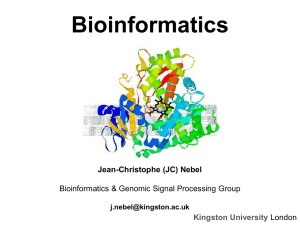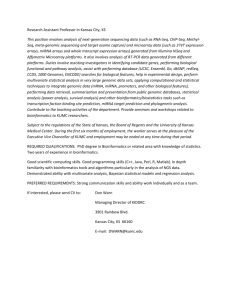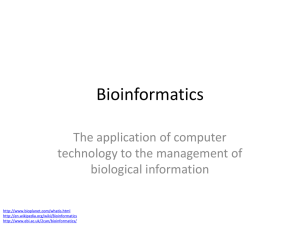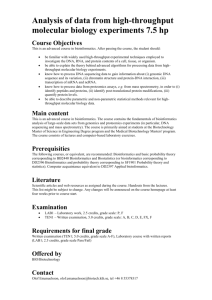- Figshare
advertisement
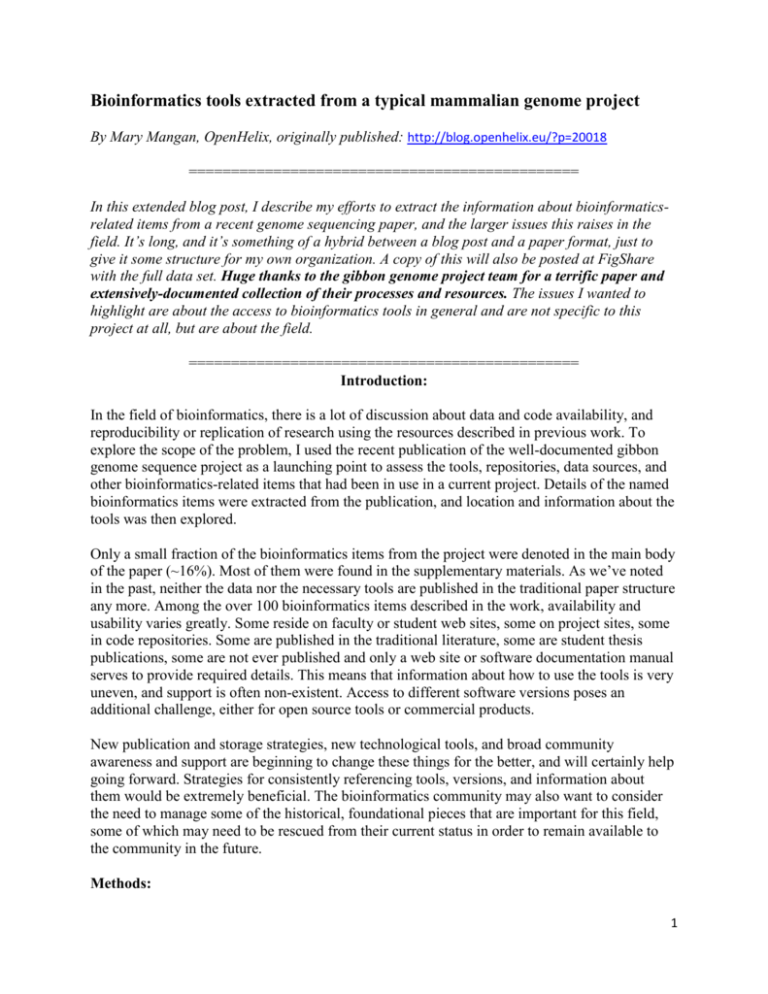
Bioinformatics tools extracted from a typical mammalian genome project By Mary Mangan, OpenHelix, originally published: http://blog.openhelix.eu/?p=20018 ============================================== In this extended blog post, I describe my efforts to extract the information about bioinformaticsrelated items from a recent genome sequencing paper, and the larger issues this raises in the field. It’s long, and it’s something of a hybrid between a blog post and a paper format, just to give it some structure for my own organization. A copy of this will also be posted at FigShare with the full data set. Huge thanks to the gibbon genome project team for a terrific paper and extensively-documented collection of their processes and resources. The issues I wanted to highlight are about the access to bioinformatics tools in general and are not specific to this project at all, but are about the field. ============================================== Introduction: In the field of bioinformatics, there is a lot of discussion about data and code availability, and reproducibility or replication of research using the resources described in previous work. To explore the scope of the problem, I used the recent publication of the well-documented gibbon genome sequence project as a launching point to assess the tools, repositories, data sources, and other bioinformatics-related items that had been in use in a current project. Details of the named bioinformatics items were extracted from the publication, and location and information about the tools was then explored. Only a small fraction of the bioinformatics items from the project were denoted in the main body of the paper (~16%). Most of them were found in the supplementary materials. As we’ve noted in the past, neither the data nor the necessary tools are published in the traditional paper structure any more. Among the over 100 bioinformatics items described in the work, availability and usability varies greatly. Some reside on faculty or student web sites, some on project sites, some in code repositories. Some are published in the traditional literature, some are student thesis publications, some are not ever published and only a web site or software documentation manual serves to provide required details. This means that information about how to use the tools is very uneven, and support is often non-existent. Access to different software versions poses an additional challenge, either for open source tools or commercial products. New publication and storage strategies, new technological tools, and broad community awareness and support are beginning to change these things for the better, and will certainly help going forward. Strategies for consistently referencing tools, versions, and information about them would be extremely beneficial. The bioinformatics community may also want to consider the need to manage some of the historical, foundational pieces that are important for this field, some of which may need to be rescued from their current status in order to remain available to the community in the future. Methods: 1 From the Nature website, I obtained a copy of the recently published paper: Gibbon genome and the fast karyotype evolution of small apes (Carbone et al, 2014). From the text of the paper and the supplements, I manually extracted all the references to named database tools, data source sites, file types, programs, utilities, or other computational moving parts that I could identify. There maybe be some missed by this process, for example, names that I didn’t recognize or didn’t connect with some existing tool (or some image generated from a tool, perhaps). Some references were to “in house Perl scripts” or other “custom” scenarios were not generally included unless they had been made available. Pieces deemed as being done “in a manner similar to that already described” in some other reference were present, and I did not go upstream to prior papers to extract those details. Software associated with laboratory equipment, such as sequencers (located at various institutions) or PCR machines were not included. So this likely represents an under-count of the software items in use. I also contacted the research team for a couple of additional things, and quickly received help and guidance. Using typical internet search engines or internal searches at publisher or resource sites, I tried to match the items to sources of software or citations for the items. What I put in the bucket included specific names of items or objects that would be likely to be necessary and/or unfamiliar to students or researchers outside of the bioinformatics community. Some are related, but different. For example, you need to understand what “Gene Ontology” is as a whole, but you also need to know what “GOslim” is, a conceptual difference and a separate object in my designation system here. Some are sub-components of other tools, but important aspects to understand (GOTERM_BP_FAT at DAVID or randomBed from BEDTools) and are individual named items in the report, as these might be obscure to non-practitioners. Other bioinformatics professionals might disagree with their assignment to this collection. We may discuss removal or inclusion of these in discussions about them in future iterations of the list. Results: After creating a master list of references to bioinformatics objects or items, the list was checked and culled for duplicates or untraceable aspects. References to “in house Perl scripts” or other “custom” scripts were usually eliminated, unless special reference to a code repository was provided. This resulted in 133 items remaining. How are they referenced? Where in the work? Both the main publication (14 PDF pages) and the first Supplementary Information file (133 PDF pages) provided the names of bioinformatics objects in use for this project. All of the items referenced in the main paper were also referenced in the supplement. The number of named objects in the main paper was 21 of the 133 listed components (~16%). This is consistent with other similar types of consortium or “big data” papers that I’ve explored before: the bulk of the necessary information about software tools, data sources, methods, parameters, and features have been in the extensive supplemental materials. The items are referenced in various ways. Sometimes they are named in the body of the main text, or the methods. Sometimes they are included as notes. Sometimes tools are mentioned only in figure legends, or only in references. In this case, some details were found in the “Author information” section. 2 As noted above, most were found in the supplemental information. And in this example, this could be in the text or in tables. This is quite typical of these large project papers, in our experience. Anyone attempting to text-mine publications for this type of information should be aware of this variety of locations for this information. Which bioinformatics objects are involved in this paper? Describing bioinformatics tools, resources, databases, files, etc, has always been challenging. These are analogous to the “reagents” that I would have put in my benchwork biology papers years ago. They may matter to the outcome, such as enzyme vendors, mouse strain versions, or antibody species details. They constitute things you would need to reproduce or extend the work, or to appropriately understand the context. But in the case of bioinformatics, this can mean file formats such as the FASTQ or axt format from UCSC Genome Browser. They can mean repository resources like the SRA. They can be various different versioned downloaded data sets from ENSEMBL (version 67, 69, 70, or 73 here, but which were counted only once as ENSEMBL). It might be references to Reactome in a table. With this broad definition in mind, Table 1 provides the list of named bioinformatics objects extracted from this project. The name or nickname or designation, the site at which it can be found (if available), and a publication or some citation is included when possible. Finally, a column designates whether it was found in the main paper as well. What is not indicated is that some are references multiple times in different contexts and usages, with might cause people to not realize how frequently these are used. For example, ironically, RepeatMasker was referenced so many times I began to stop marking it up at one point. Table 1. Software tools, objects, formats, files, and resources extracted from a typical mammalian genome sequencing project. See the web version supplement to this blog post: http://blog.openhelix.eu/?p=20002, or access at FigShare: 3 What can we learn about the source or use of these items? Searches for the information about the source code, data sets, file types, repositories, and associated descriptive information about the items yields a variety of access. Some objects are associated with traditional scientific publications and have valid and current links to software or data (but are also sometimes incorrectly cited). These may be paywalled in certain publications, or are described in unavailable meeting papers. Some do not have associated publications at all, or are described as submitted or in preparation. Some tools remain unpublished in the literature, long after they’ve gone into wide use, and their documentation or manual is cited instead. Some reside on faculty research pages, some are student dissertations. Some tools are found on projectspecific pages. Some exist on code repositories—sometimes deprecated ones that may disappear. A number of them have moved from their initial publications, without forwarding addresses. Some are allusions to procedures other publications. Some of them are like time travel right back to the 1990s, with pages that appear to be original for the time. Some may be at risk of disappearing completely the next time an update at a university web site changes site access. Other tools include commercial packages that may have unknown details, versions, or questionable sustainability and future access. When details of data processing or software implementations are provided, the amount can vary. Sometimes parameters are included, others not. Missing tool I wanted to have One of my favorite data representations in the project results was Figure 2 in the main paper, Oxford grids of the species comparisons organized in a phylogenetic tree structure. This 4 conveyed an enormous amount of information in a small area very effectively. I had hoped that this was an existing tool somewhere, but upon writing to the team I found it’s an R script by one of the authors, with a subsequent tree arrangement in the graphics program “Illustrator” by another collaborator. I really liked this, though, and hope it becomes available more broadly. Easter eggs The most fun citation I came across was the page for PHYLIP, and the FAQ and credits were remarkable. Despite the fact that there is no traditional publication available to me, a lengthy “credits” page offers some interesting insights about the project. The “No thanks to” portion was actually a fascinating look at the tribulations of getting funding to support software development and maintenance. The part about “outreach” was particularly amusing to us: “Does all this “outreach” stuff mean I have to devote time to giving workshops to mystified culinary arts students? These grants are for development of advanced methods, and briefing “the public or non-university educators” about those methods would seem to be a waste of time -though I do spend some effort on fighting creationists and Intelligent Design advocates, but I don't bring up these methods in doing so.” Even the idea of “outreach” and support for use of the tools is certainly unclear to the tool providers, apparently. Training? Yeah, not in any formal way. Discussion: The gibbon genome sequencing project provided an important and well-documented example of a typical project in this arena. In my experience, this was a more detailed collection and description than many other projects I’ve explored, and some tools that were new and interesting to me were provided. Clearly an enormous number and range of bioinformatics items, tools, repositories, and concepts are required for the scope of a genome sequencing project. Tracing the provenance of them, though, is uneven and challenging, and this is not unique to this project— it’s a problem among the field. Current access to bioinformatics objects is also uneven, and future access may be even more of a hurdle as aging project pages may disappear or become unusable. This project has provided an interesting snapshot of the state of play, and good overview of the scope of awareness, skills, resources, and knowledge that researchers, support staff, or students would need to accomplish projects of similar scope. It used to be simpler. We used to use the small number of tools on the VAX, uphill, in the snow, both ways, of course. When I was a grad student, one day in the back of the lab in the early 1990s, my colleague Trey and I were poking around at something we’d just heard about—the World Wide Web. We had one of those little funny Macs with the teeny screens, and we found people were making texty web pages with banal fonts and odd colors, and talking about their research. Although we had both been using a variety of installed programs or 5 command lines for sequence reading and alignment, manipulation, plasmid maps, literature searching and storage, image processing, phylogenies, and so on—we knew that this web thing was going to break the topic wide open. Not long after, I was spending more and more time in the back room of the lab, pulling out sequences from this NCBI place (see a mid-1990s interface here), and looking for novel splice variants. I found them. Just by typing—no radioactivity and gels required by me! How cool was that? We relied on Pedro’s List to locate more useful tools (archive of Pedro's Molecular Biology Search and Analysis Tools.). Both of us then went off into postdocs and jobs that were heavily into biological software and/or database development. We’ve had a front seat to the changes over this period, and it’s been really amazing to watch. And it’s been great for us—we developed our interests into a company that helps people use these tools more effectively, and it has been really rewarding. At OpenHelix, we are always trying to keep an eye on what tools people are using. We regularly trawl through the long, long, long supplementary materials from the “big data” sorts of projects, using a gill net to extract the software tools that are in use in the community. What databases and sites are people relying on? What are the foundational things everyone needs? What are the cutting-edge things to keep a lookout for? What file formats or terms would people need to connect with a resource? But as I began to do it, I thought: maybe I should use this as a launching point to discuss some of the issues of software tools and data in genomics. If you were new to the field and had to figure out how a project like this goes, or what knowledge, skills, and tools you’d need, can you establish some idea of where to aim? So I used this paper to sort of analyze the state of play: what bioinformatics sites/tools/formats/objects/items are included in a work of this scope? Can you locate them? Where are the barriers or hazards? Could you learn to use them and replicate the work, or drive forward from here? It was illuminating to me to actually assemble it all in one place. It took quite a bit of time to track the tools down and locate information about them. But it seemed to be a snapshot worth taking. And I hope it highlights some of the needs in the field, before some of the key pieces become lost to the vagaries of time and technology. And also I hope the awareness encourages good behavior in the future. Things seem to be getting better—community pressure to publish data sets and code in supported repositories has increased. We could use some standardized citation strategies for the tools, sources, and parameters. The US NIH getting serious about managing “big data” and ensuring that it can be used properly has been met with great enthusiasm. But there are still some hills left to climb before we’re on top of this. Reference: Carbone L., R. Alan Harris, Sante Gnerre, Krishna R. Veeramah, Belen Lorente-Galdos, John Huddleston, Thomas J. Meyer, Javier Herrero, Christian Roos, Bronwen Aken & Fabio Anaclerio & al. (2014). Gibbon genome and the fast karyotype evolution of small apes, Nature, 513 (7517) 195-201. DOI: http://dx.doi.org/10.1038/nature13679 6




